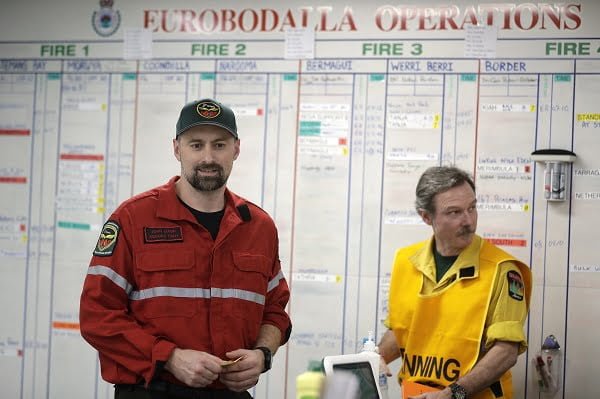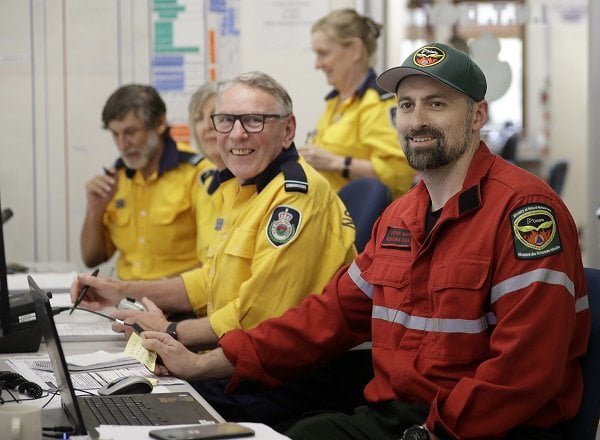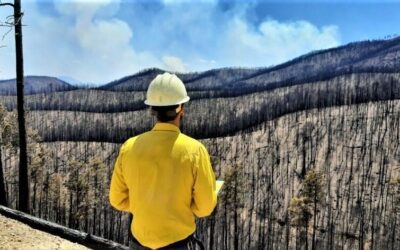A look at what some firefighters from the U.S. and Canada are doing

In this Thursday, Jan. 9, 2020, photo, Terrance Gallegos, right, operations section chief at Santa Fe National Forest in the U.S., works in the situation room at the Rural Fire Service office in Moruya, Australia. The U.S., Canada and New Zealand have sent hundreds of firefighters to Australia to help local crews battle its deadly wildfires. The firefighters have come as part of a reciprocal deal which has previously seen Australians posted in North America. Many of the firefighters have specialized skills such as managing air operations or logistics. (AP Photo/Rick Rycroft)
By NICK PERRY Associated Press
MORUYA, Australia (AP) — Bimbimbie. Wamban. Ulladulla.
Australia’s place names can be a mouthful to pronounce, and it’s one of the challenges that Canadian firefighter John Mash has faced after arriving to help battle the country’s deadly wildfires. American firefighter Terrance Gallegos, meanwhile, has been impressed with the scale of the local volunteer effort.
Mash is among nearly 100 firefighters from Canada and Gallegos among more than 250 firefighters from the U.S. who have arrived or will soon to help battle the fires that have killed at least 26 people. Many of the international firefighters specialize in skills such as managing air operations or logistics, although the U.S. is sending more front-line staff.
The firefighters have come as part of a reciprocal deal which has previously seen Australians posted in North America.
The Associated Press spoke to Mash and Gallegos in the New South Wales town of Moruya, where they have been stationed at the Rural Fire Service headquarters.

In this Thursday, Jan. 9, 2020, photo, John Mash, left, a fire operations supervisor for the Ministry of Natural Resources in Ontario, Canada, works in the situation room at the Rural Fire Service office in Moruya, Australia. The U.S., Canada and New Zealand have sent hundreds of firefighters to Australia to help local crews battle its deadly wildfires. The firefighters have come as part of a reciprocal deal which has previously seen Australians posted in North America. Many of the firefighters have specialized skills such as managing air operations or logistics. (AP Photo/Rick Rycroft)
___
JOHN MASH, 42, fire operations supervisor in Ontario, Canada. Employed by the Ministry of Natural Resources. Twenty-three seasons fighting fires.
Helping out: “When we got the call, we were all very pleased that we could help out as they have in the past on the other side of the world.”
Role in Australia: “A lot of us are filling different command roles, and we’ve been working with them to see what we can bring to the table and help out as much as we can … I’m taking calls from the call center and helping distribute resources to where they need to be on a case-by-case basis.”
Challenges: “Pretty much everything when I pick up the phone. Local town names or geographic areas, I’ve had a difficult time repeating, and obviously knowing where those are. So it takes me a bit of time. But over the last couple of days I’ve definitely improved on that.”
International cooperation: “Different fire agencies in different countries are getting more adept over the last few years, definitely as the fire seasons seem to be picking up, at sharing resources. Any particular area can be impacted by fire, and sometimes it overwhelms the resources of any particular agency.”
Lessons: “Every geographic area has its challenges with fuel types that will burn. One that really stood out to us were the stringy bark trees and eucalyptus trees. Eucalyptus is a very volatile fuel type and can lead to significant fire behavior.
“So it’s interesting for us to see those types of challenges. And that type of information we can bring back with us to our home agencies and that helps us better understand fire behavior.”

In this Thursday, Jan. 9, 2020, photo, John Mash, right, a fire operations supervisor for the Ministry of Natural Resources in Ontario, Canada, works in the situation room at the Rural Fire Service office in Moruya, Australia. The U.S., Canada and New Zealand have sent hundreds of firefighters to Australia to help local crews battle its deadly wildfires. The firefighters have come as part of a reciprocal deal which has previously seen Australians posted in North America. Many of the firefighters have specialized skills such as managing air operations or logistics. (AP Photo/Rick Rycroft)
___
TERRANCE GALLEGOS, 39, operations section chief at Santa Fe National Forest, New Mexico. Employed by the U.S. Forest Service. Twenty-two seasons fighting fires.
Lending a hand: “I’ve been on incidents when Australians have actually come and assisted me on my division and helped me out operationally, and it’s a great opportunity to come here and help our brothers and sisters from Australia with their fire operations and just lend them a hand.”
The Australian wildfires: “Its incredible. It’s covering large portions of the country. And just in this area here along the coast, there’s a lot of fire out here and it has impacted a lot of folks. We’re just glad that we’re here to try to bring some help and some normalcy back to the communities.”
Challenges: “It’s a different fuel type than what we’re used to dealing with in the states. It’s got some more explosive components to it than we’re used to dealing with. But when it gets down right to it, fire is fire.”
The Australian volunteers: “Back home we have volunteer firefighters, but typically they only help out for a couple of days or so until the paid firefighters can get in place and take care of things. And it’s amazing that these folks are out here sacrificing all this time and energy, for weeks now. So it’s incredible. Really incredible.”
The food: “It’s good. In New Mexico, we’re used to a lot of spicy food, and we’ve gotten a little bit of that here, so it feels a little bit like home.”

In this Thursday, Jan. 9, 2020, photo, Terrance Gallegos, right, operations section chief at Santa Fe National Forest in the U.S., works in the situation room at the Rural Fire Service office in Moruya, Australia. The U.S., Canada and New Zealand have sent hundreds of firefighters to Australia to help local crews battle its deadly wildfires. The firefighters have come as part of a reciprocal deal which has previously seen Australians posted in North America. Many of the firefighters have specialized skills such as managing air operations or logistics. (AP Photo/Rick Rycroft)
All contents © copyright 2020 The Associated Press. All rights reserved.




